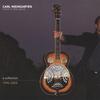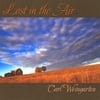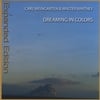Tuesday, December 4, 2012
1987
When my Delay Tactics bandmates told me they didn’t want to tour, I decided to hit the road on my own. This was at the end of 1986. We had been together for five years and our two albums had reached a peak in radio play. Touring was never part of our plan, but since the band had reached that crucial step in the ladder of success, this was an opportunity I knew would not last long and did not want to miss.
At first I was nervous about playing shows by myself, assuming the audiences had been listening to the group albums. I spent weeks writing a set of guitar music that I could not only perform solo, but was still in the tradition of the Delay Tactics sound. The technology to create a one-man-band experience was available at the time, and a few music pioneers had already led the way, but the gear was bulky, buggy, and expensive. I needed a rig that was lean, flexible, and could be packed into a suitcase. Making the most of the pedals I had, including a technical innovation called the Electro-Harmonix16-Second Delay, I assembled at my feet what was essentially a mini digital recording studio. With just my guitar and drum machine as the instruments, I could play, record, loop and layer tracks into a live performance. I played in cafes, theaters, student centers, and night clubs at a time when very few artists were touring this kind of music.
The cross-country road trips I took were sometimes more eventful than the gigs themselves, but I’m glad I did it while I was naive enough to risk everything and young enough to recover from it. The drives were long and tedious, often lasting late into the night as I tried to cover as many miles as possible. I could never bring enough music to listen to, and ran my cassette player without mercy until it would eat tapes in rebellion. But I got to see a lot of country and experience being on my own in a way I had never done before. Exhausted after many hours of driving and unable to find a motel, I’d park at a rest stop, lie across the front seats and sleep for a few hours before starting again.
Of the shows I did that year, the highest profile venue was opening for Bill Bruford’s Earthworks band at Night Stage in Boston. Bill Bruford was a very successful rock and jazz drummer whose most famous work was with the groups Yes and King Crimson. Earthworks was his own band and this concert was the second show of their first U.S. tour. I was brought in as the opening act under the wing and heavy airplay of radio station WZBC-FM.
On this occasion I could afford to fly rather than drive, and when I arrived at the club to set up, the soundcheck for Earthworks was still going on. Mr. Bruford, a tall and imposing figure, was very professional. After barking orders from the stage to the sound man, he offered me his thanks for waiting. Later I spoke with him backstage. As he warmed up by rapidly drumming on a stack of beer cases, I mentioned his recent Cloud About Mercury record with guitarist David Torn and how much I liked the album. Bill had seen my soundcheck and he was gracious. “Oh yes,” he said, smiling, “he’s (Torn) your kind of guitarist!”
It was a packed house and the performance flew by in a blur. In a rare gesture of humanity, the club sound engineer actually recorded my performance and gave me the tape. In that pre-Internet world, cassettes were king and could be sent to radio stations for broadcast later. Recently, I pulled the tape from storage and discovered that we had actually played two sets that night, a day before my birthday July 16, 1987. The only camera I had at the time was a Polaroid, which I rarely had time to use. Thankfully, however, my friend Susanne May was living in Boston when I did this show. A professional photographer, she came to the concert and covered the event. I’m really grateful to have these images. Aside from a box of tapes, a few letters, and newspaper clippings, this is the only evidence I have of that year on the road. --CW
Labels:
band,
Bill Bruford,
Boston,
carl weingarten,
concert,
Delay Tactics,
Earthworks,
guitar,
jazz,
looping,
music,
Night Stage,
photographs,
solo,
tour
Tuesday, October 9, 2012
"The Radio" by Carl Weingarten
The first piece of music gear I ever owned I won in a
sack race. I was around seven years
old. It was during a neighborhood picnic
held at Lewis Park in St. Louis, a small but elegant early 20th
century park at the bottom of a hill descending from Delmar Ave. Built with playing fields, walkways, a man-made
pond and fountain, Lewis Park was trafficked in the summer by moms with strollers,
softball games and necking teenagers. In
the winter, the pond became a skating and hockey rink, and the hillside terrain
provided plenty of steep, if brief, downhill sledding.
Up until about the 5th grade, I was the
fastest kid in my class. This was no
small achievement. Our school system was
among the first in St. Louis to be integrated, and the city wide diversity
included students of all shapes and sizes.
My status reached its peak during a gym class in the 4th grade. The coach held a 50-yard dash runoff. The contest came down to me and a tall
African-American girl. She was timed at
7.2 seconds, but I came in at 7 flat. Not
bad for a steroid-free 4th grader running in street clothes. By the next year however the kids who were
destined to be bigger and taller began sprouting up and my edge began to fade
like Olympic glory. Still, I remained a
good sprinter and for many years after, my self-image came through athletics.
During this time, Lewis Park hosted an annual summer
picnic, organized by a neighborhood association and attended by the families
living nearby. There was food, games,
races, and at the end, a teenage rock band.
The sack race I was in was close, as I vaguely remember, and I was delighted
to have won. No sooner had I finished, still
catching my breath, an adult came over to me and presented the winning prize. A prize, really? I opened the small box and was overcome to
receive a genuine Panasonic AM transistor radio. For an eight-year-old in the mid-1960s, this was
mind-blowing technology. About the size
of a cigarette pack, the radio was every kid’s 24/7 access to popular culture.
In St. Louis this meant DJ Johnny Rabbit, The Beatles, Motown, Sunday
preachers, twangy stuff, and of course, Cardinal baseball.
In the months that followed, the radio remained my prized
possession. Many a nine-volt battery
died in my service, at school during the day, under my pillow at night or
against my ear during our family road trips - the stations along the highway
emerging from and then disappearing back into static.
At one point during this period of obsession, I
expressed to my Mom how I couldn’t imagine my life had I not won the
radio. “You almost lost, Carl,” she said,
a little exasperated. I was
shocked. “There was a girl catching up
with you but she fell down.” This girl,
I suspect, was the one who lived two blocks away, and who I usually saw only at
our grade school. The neighborhood kids
tended to cluster from street to street, and our stretch of territory were all
boys, and often a bit too Lord of The
Flies for most girls in our vicinity.
On one occasion however we were out riding bikes and ended up on the
street where the girl lived. She was
playing with friends and we all hung out for a while. The kid talk got around to who was a fast
runner. She said she was fast, too. So we decided to race uphill to a set of cars
at the end of the block. We raced twice,
as I remember, and we were basically even both times. I had met my running rival. She was cute, she was fast, and she was a
girl. Sadly, I was not yet old enough to appreciate the sum of those
qualities.
Since her family lived across from the park, she would
likely have been at the picnic on that day, and I may have seen her at one
point. So when my mother broke the news
about my close call, it was this girl who flashed before my eyes. This shattering of my prowess fueled a
certain guilt about winning the radio, and opened a dark door to an alternative
universe without the radio. I had won, but perhaps I was not meant to win. I hadn’t yet learned that it’s okay to get
lucky, and it’s no biggie if you don’t. In
a competitive world, there’s always someone a step ahead and someone else at
your heels. Just stay on your feet and
things will work out.
In time my radio was replaced by a record player. My taste in music began to change, and as a
teenager, socializing was about the LPs you owned, and not the stations you
listened to. AM was no longer cool. Fortunately I kept the radio, where it lay quietly
in one box or another, for the next 40 years.
Most of the gadgets I had as a kid eventually quit working, and were usually
subjected to a screwdriver autopsy before the plastic and wire remains were
interned to the trash. But this radio was
special. It never quit working, and so I
kept it.
Looking at the radio now, it’s a classic of period style
and design. Sleek, small, and
elegant. Most striking to me is the
cluster of transistors in the back side, the circuits compressed into an urban
grid of beautiful Mad Men era technology.
Labels:
AM,
baseball,
Cardinals,
Grade School,
kids,
Lewis Park,
music,
neighborhood,
Panasonic,
picnic,
pop,
racing,
Radio,
running,
soul,
st. louis,
stations,
transisters
Thursday, September 20, 2012
In Studio September 2012
Back in the studio with several new recordings underway, and working
with new musician friends as well, including Pat Duffey and Suellen
Primost. Here's a clip of our first rehearsal. --CW
Session Photos: "The Lodge" by Carl Weingarten
SESSION
PHOTOS: I met guitarist/producer/writer
Barry Cleveland in 1991 during a visit to San
Francisco, shortly before moving there the following
year. Robert Powell drove me to Barry’s
house in the Oakland Hills which was referred to as “The Lodge”. It was a combo live-work-studio-jam-lounge-hotel-party-recovery-sanctuary
meeting place for musicians and artists.
After relocating from St. Louis,
I was invited into this wonderful community of musicians. Barry and I became friends and we began
working together. For months after, and
I don’t know how I did it, I carted my 80 pound 8-Track TASCAM recorder back
and forth across the bay to Barry’s studio where we tracked and mixed my CD,
“The Acoustic Shadow”. This is one of my
favorite pictures. I took this photo
during a rare daytime session as Barry recorded his signature guitar on Light
Years Dark Skies. It captures the scene
as it was; the studio-living room with gear everywhere and with Barry at the
controls and inside the music. The song also features Barbara Else on flute,
Dan Reiter on cello and I on “Morricone” guitar. -CW
Labels:
album,
Barbara Else,
Barry Cleveland,
carl weingarten,
CD,
Dan Reiter,
Guitar Player,
home studio,
music,
photo,
recording,
studio,
The Acoustic Shadow,
The Lodge
Wednesday, September 19, 2012
Session Photos: "Alex de Grassi" by Carl Weingarten
SESSION
PHOTOS: In the late 1990s, my friend
Michael Manring was kind enough to put in a good word for me at The Noe Valley
Ministry in San Francisco,
and they booked me as the opening act for an Alex de Grassi concert. Alex is among my favorite guitarists, and
though we had met before, it was a pleasure getting acquainted with him for the
show. Near the end of his set, we played
together on a new song, which led to him, several weeks later, recording on the
same piece, “Read The River” for my CD escapesilence. (You can download the song here: http://snd.sc/O6k6lr) It was an honor to have Alex in my humble San Francisco apartment
studio, though my neighbors unfortunately were less welcoming. It was after 9pm when I snapped this photo of
Alex as he was tuning up. Behind the
wall next to Alex was my neighbor’s bedroom.
The couple apparently kept early hours, and during one take, I heard a
rumble. When I pulled off my headphones,
the neighbors were banging on the wall, “Turn it down!”. I cleared things up with them, but I felt bad
for Alex. Here was a world class
musician who performs for thousands of people every year, and yet my neighbors
complained that the (god forbid) acoustic guitar was too loud. In any case, Alex was a trooper, and wonderful,
and the session went great. “Read The
River” includes Michael Manring on bass, Robert Powell on pedal steel, Alex on
guitar, with myself on dobro.
Labels:
album,
Alex de Grassi,
apartment,
carl weingarten,
CD,
escapesilence,
michael manring,
music,
photo,
Read The River,
recording,
session
Session Photos: "Fareed Haque" by Carl Weingarten
SESSION
PHOTOS: I met jazz guitarist Fareed Haque through my friend Joe Venegoni in
1990. Joe and I were still living in St. Louis at the time. Our Critical Path CD was in the works, and
Joe suggested bringing in Fareed to play on a few songs. I resisted at first as I didn’t know Fareed
or how his sound might impact the album.
But Joe insisted, and he was absolutely right. Fareed was spot on. The Blue Note Records guitarist turned out to
be a recognized modern jazz guitar master and improviser. Fareed came in from Chicago, and upon his arrival to the studio,
he immediately dug in and recorded several inspired performances. At one point, setting his trademark nylon
acoustic aside, Fareed played my electric guitar on one song, breaking a string
in the process, which I hung proudly on my studio wall. While Fareed’s playing was excellent, the
most inspiring moment for me was his work on “A Window”, a song I had composed
and recorded as a solo guitar piece a few years earlier. Joe and I had agreed to record the song
again, with orchestration. Fareed
quickly learned the melody and began, like spreading wildfire, to improvise and
embellish on the theme. It was startling
how quickly he connected with the tune, and for the first time in my life, I
heard my music played by someone other than myself. If you’re a composer, it’s like witnessing
your child’s college graduation. Fareed
infused new energy into the composition and it was affirming to hear my music
in such capable hands. I didn’t take
any photos at the session, but I did capture Fareed in action a few years
later, during a recording session jam in the bay area. The group that day featured Fareed, guitarist
Henry Kaiser, bassist Michael Manring (also in the photo), among others.
Subscribe to:
Comments (Atom)















